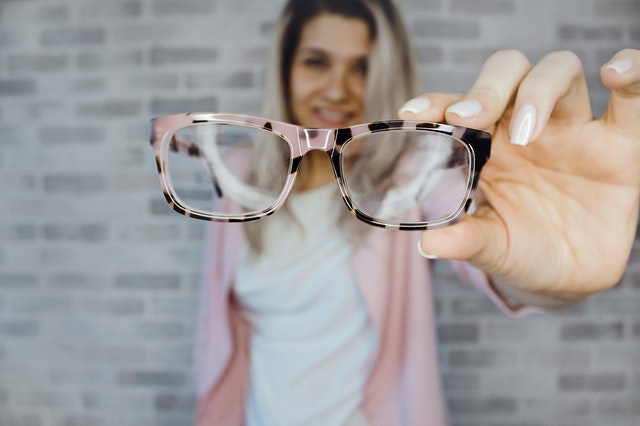
Image Source: Pexels
People who wear eyeglasses know all about the woes that come with frames that don’t cater to their personal style preference. But many don’t consider their face shape that’s making the glasses look funky.
It’s true. The shape of your face plays a huge role in whether certain styles of glasses will suit you. But matching frames to your face is easier said than done. You might have heard the typical tips and tricks like picking a shape that balances out your features. But there is much more to it.
In this article, we will discuss how to find out your face shape and size and how to select the perfect frames for your face and skin tone. Remember, the advice in this article is generalized as everyone is different (and so is every brand- a brand like Barton Perreira will fit differently compared to Oakley, and so on).
Finding Your Face Size: Wide or Narrow?
The first step you should take before shopping for new eyeglasses is to find out your exact face size, meaning if it is narrow, medium, or wide. This will influence what size eyeglasses look good and feel comfy on you.
To do this, you are going to measure your face from temple to temple. This is important because you do not want to pick out frames that are too small or too large for your face. (See also: A Simple Guide to Select Glasses Online)
The best method for doing this is to measure your face with a straight ruler.
Using measuring tape is far more difficult since it can have inconsistencies.
While looking at your reflection in a mirror, use the ruler to measure the distance between your right temple and your left one. The width of your face should match the total width of your eyeglasses. To find out the total width of your eyeglass frames, add the frame width to the nose bridge width. The total length needs to be at least equal to your face width.
Narrow Width Faces
Narrow faces typically have a width measuring between 110 mm and 125 mm. Select frames that have a total length size between 115 mm and 129 mm.
Medium Narrow Width
If you have a medium narrow face, it will measure between 125 mm and 135 mm. Select frames between 129 mm and 140 mm long.
Wide Faces
Your face is wider if its measurements are between 135 mm and up to 152 mm or above. Opt for frames between 139 mm to 155 mm or above.
Measuring Your Face Length
To find out what your face length is, use a ruler to measure from the top of your forehead where your hairline starts to the bottom of your chin. After you get your face length, utilize this easy formula:
- If your length is greater than the width, you have a long face.
- If your width is approximately the same as the length or a little bit higher, you have a short face.
Glasses for Tall Faces

Image Source: Pexels
Long lenses will work best with your physiognomy. They can take up more space and create an even ration between your face and your glasses.
Glasses for Short Faces
Petite lenses will work for your short face because they don’t take any length away from your face. Try avoiding thick frames because it may make your face appear to be smaller. Another styling tip is to choose clear frames, which blend in and don’t take away from your face’s length.
Seven Primary Face Shapes
Now that you know your face size, it is time to determine its shape. There are seven primary face shapes.
- Oval Face Shape – An over face shape is considered by many to be ideal due to its balanced proportions. To maintain the natural balance of your face shape, select eyewear frames that are wider than or as wide as the broadest part of your face. Walnut-shaped frames make a great choice.
- Heart-Shaped Faces – A heart-shaped face has a wider top third and a narrower bottom third. Pick frames that are wider at the bottom to decrease the apparent width of the top of the face. Light-colored, thin frames or rimless frames that have an airy, light appearance are also great selections.
- Square Face – The characteristics of a square face shape include a long jaw and a broader forehead. The length and width of the face have the same proportions. To soften the face angles, choose frames with narrow styles, such as ovals.
- Oblong Face Shape – If you possess an oblong face shape, your face is longer than it is wide and has a long, straight cheek line. To make your face look more balanced, buy frames that have less width than depth. Frames that feature contrasting or decorative temples also add width to oblong faces.
- Diamond Face – Diamond faces boast narrower foreheads and broad cheekbones. To soften your cheekbones, opt for frames that have unique brow lines. Cat-eye or oval frame shapes are also good selections.
- Round Face Shapes – A round face shape has curved lines and no angles. To make your round face look thinner, try angular narrow frames to lengthen the face. Rectangular frames or eyeglass frames with clear bridges also make good choices.
- Triangle Face – Triangle shaped faces have narrow foreheads and widen at the chin and cheek areas. To increase width appearance and emphasize the narrow upper portions of the face, try eyewear frames that have dramatic accents with color and detailing on the brow portion of the frame.
Other Face Factors for Getting Perfect Frames

Image Source: Pexels
Face shape and size aren’t the only factors that determine what eyewear frames look ideal on you. Your hair and eye color, as well as skin tone, play important roles too.
- Skin Tones – Regardless of your skin color, skin tones are always categorized as either warm or cool. A warm complexation has a “peaches and cream” or yellow undertone, while a cool complexion has pink or blue undertones.
- Eye color – Your eye color should be used as a secondary element due to the many hues of eye color. For instance, blue eyes can range from a cool violet to a pale blue-gray, which is warm. Brown eyes can range from a warm cider shade to a cool almost black color.
- Hair color – Hair colors are also considered warm or cool. Warm hair hues include brownish-black or brown gold. Cool tones include white, strawberry blonde, Auburn, and salt and pepper hair.
After you have figured out if you are warm or cool, then find eyewear frames that cater to your hue. Some examples of frames best for cool tones are black, rose-brown, pink, jade, demi-amber, blue, plum, and magenta. For warm coloring, opt for coral, off-white, orange, copper, khaki, warm blue, fire-engine red, or gold.
It’s important to get the right eyeglass frame color, shape, and size to suit your face type. Not only will you look great, but you will feel confident.
About The Author:
Kim is a writer by profession. She mostly writes about self-care and how to maintain a good and healthy life. Apart from being a fantastic writer she also loves painting and has executed a few exhibitions to display her creativity.




